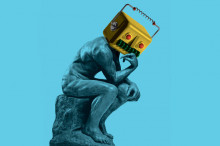
Can machines – robots – be trusted to make moral choices? Do we want to find out – or stop this technology in its tracks?
Imagine it’s a Sunday in the not-too-distant future. An elderly woman named Sylvia is confined to bed and in pain after breaking two ribs in a fall. She is being tended by a helper robot; let’s call it Fabulon. Sylvia calls out to Fabulon asking for a dose of painkiller. What should Fabulon do?
The coders who built Fabulon have programmed it with a set of instructions: The robot must not hurt its human. The robot must do what its human asks it to do. The robot must not administer medication without first contacting its supervisor for permission. On most days, these rules work fine. On this Sunday, though, Fabulon cannot reach the supervisor because the wireless connection in Sylvia’s house is down. Sylvia’s voice is getting louder, and her requests for pain meds become more insistent.
But what about armed drones? The military has developed lethal autonomous weapons systems like the cruise missile and is working on a ground robot to either shoot or hold its fire, based on its assessment of the situation within the international rules of war. It would be programmed, for example, to home in on a permissible target — a person who can be identified as an enemy combatant because he is wearing a uniform, say — or to determine that shooting is not permissible, because the target is in a school or a hospital, or has already been wounded.
There’s something peculiarly comforting in the idea that ethics can be calculated by an algorithm: It’s easier than the panicked, imperfect bargains humans sometimes have to make. But maybe we should be worried about outsourcing morality to robots as easily as we’ve outsourced so many other forms of human labor. Making hard questions easy should give us pause.
Read more here:
http://www.nytimes.com/2015/01/11/magazine/death-by-robot.html
Want to step up your writing and take it to next level? Here is what one writer suggests – reading at least 15 minutes a day.
I discovered that a reading regimen, even if only 15 minutes a day, requires discipline. William James wrote that discipline is needed in the formation of any new habit. In this case, the habit was reading regularly and outside my comfort zone. I often had to fight against an inclination to skip a day. But the relative brevity of the selections kept me on track—a hint to teachers who assign too much and thereby encourage cribbing and cramming. With a 15-minute assignment, I could push on, knowing that the end was near
Read more here:
http://www.wsj.com/articles/paula-marantz-cohen-a-year-of-15-minute-daily-doses-from-the-harvard-classics-1419637070?KEYWORDS=paula+marantz+cohen

What is happening to innovation in America?
Silicon Valley, where toddler-aged companies regularly sell for billions, may be the most vibrant sector of the U.S. economy, fueling a boom in markets from housing to high-end toast (how many $4-a-slice artisanal bread bars does a place really need?). But as recent innovations — apps that summon cabs, say, or algorithms that make people click on ads — have been less than world-changing, there is a fear that the idea machine is slowing down. And while Silicon Valley mythology may suggest that modern-day innovation happens in garages and college dorm rooms, its own foundations were laid, in large part, through government research. But during the recession, government funding began to dwindle. The federal government now spends $126 billion a year on R. and D., according to the National Science Foundation. (It’s pocket change compared with the $267 billion that the private sector spends.) Asian economies now account for 34 percent of global spending; America’s share is 30 percent.
But in the past few years, the thinking has changed, and tech companies have begun looking to the past for answers. In 2010, Google opened Google X, where it is building driverless cars, Internet-connected glasses, balloons that deliver the Internet and other things straight out of science fiction. Microsoft Research just announced the opening of a skunk-works group called Special Projects. Even Bell Labs announced this month that it is trying to return to its original mission by finding far-out ways to solve real-world problems.
Read the entire article here:
http://www.nytimes.com/2014/06/15/magazine/silicon-valley-tries-to-re-make-the-idea-machine.html

Nowadays, though we may still idolize the charismatic leader or creative genius, almost every decision of consequence is made by a group. And groups of smart people can make horrible decisions — or great ones. Indeed, the smartest teams were distinguished by three characteristics.
First, their members contributed more equally to the team’s discussions, rather than letting one or two people dominate the group.
Second, their members scored higher on a test called Reading the Mind in the Eyes, which measures how well people can read complex emotional states from images of faces with only the eyes visible.
Finally, teams with more women outperformed teams with more men. Indeed, it appeared that it was not “diversity” (having equal numbers of men and women) that mattered for a team’s intelligence, but simply having more women. This last effect, however, was partly explained by the fact that women, on average, were better at “mindreading” than men.
Read more here:
http://www.nytimes.com/2015/01/18/opinion/sunday/why-some-teams-are-smarter-than-others.html
As news reports hit us piecemeal regarding global terrorism it’s difficult to build a ‘mental map’ of where those places are around the globe.
In this report, Martha Raddatz reports on recent Global Counter-terror operations, interviewing some of the most well-known experts in the field.
You can watch the video here.

In a post earlier this month, I suggested that what the future comports impacts our personal lives, our families and even our fortunes. We all want to know what the future will hold, but few of us have the time to deep dive into the wealth of information that can give us some sense of what it will be.
But the “pros from Dover” at the National Intelligence Council (NIC), the parent agency for the 16 components (CIA, DIA, NSA etc.) of United States intelligence enterprise have done it.
The NIC has released their comprehensive quadrennial report forecasting global trends that have a major impact on our world, “Global Trends 2030: Alternative Worlds.” In shorthand –GT2030. Global Trends 2030 helps us have an informed and well-nuanced view of the future. I’ve “deconstructed” this report in this – and will continue to do so in future – posts:
Read more about the future in my post on the Defense Media Network website here:
http://www.defensemedianetwork.com/stories/global-trends-2030-what-it-is-and-why-it-matters/

Do you have a New Year’s resolution to have more time for yourself – time to do the things you really love doing? Here’s how to keep it – the easy way.
Checking email less often may reduce stress in part by cutting down on the need to switch between tasks. An unfortunate limitation of the human mind is that it cannot perform two demanding tasks simultaneously, so flipping back and forth between two different tasks saps cognitive resources. As a result, people can become less efficient in each of the tasks they need to accomplish. In addition to providing an unending source of new tasks for our to-do lists, email could also be making us less efficient at accomplishing those tasks.
Taste freedom – leave your e-mail alone!
Read more here:
http://www.nytimes.com/2015/01/11/opinion/sunday/stop-checking-email-so-often.html

How do movies and television shows live on: with novelizations. This “reverse flow” method of the normal publishing and media methodology is back – with a vengeance.
Studios and producers have long used novelizations as a way to capture fans’ attention between television seasons, or installments of blockbuster film franchises. For publishers, tie-in books have become cash cows that offer instant brand recognition and access to huge fan bases for vastly larger media. One of the longest running, most successful tie-in series, the “Star Wars” novels, dates to 1976 and now has more than 125 million copies in print.
Read more here:
http://www.nytimes.com/2015/01/05/business/media/popular-tv-series-and-movies-maintain-relevance-as-novels.html

One of the most important tasks of American statecraft over the next decade will be to lock in a substantially increased investment – diplomatic, economic, strategic, and otherwise – in the Asia-Pacific region… At a time when the region is building a more mature security and economic architecture to promote stability and prosperity, U.S. commitment there is essential… Beyond our borders, people are also wondering about America’s intentions – our willingness to remain engaged and to lead. In Asia, they ask whether we are really there to stay, whether we are likely to be distracted again by events elsewhere, whether we can make – and keep – credible economic and strategic commitments, and whether we can back those commitments with action.
Read more about this rebalance in my post on the Defense Media Network website here.

Many of us make resolutions at the beginning of the year. Some of them are very specific. But it might be worth taking a “strategic pause” and do something business does so well – come up with a mission statement – a personal mission statement that defines why you want to do the things you’ll promise yourself you’ll do. It just might be the key that unlocks a brighter future.
Said another way, forget the New Year’s resolution. This year, try creating a personal mission statement instead.
”To get started on your personal mission statement, ask yourself the following questions used by the Corporate Athlete program:
- How do you want to be remembered?
- How do you want people to describe you?
- Who do you want to be?
- Who or what matters most to you?
- What are your deepest values?
- How would you define success in your life?
- What makes your life really worth living?
Use your answers to craft a personal mission statement that reveals your ultimate purpose in life. Rather than listing a behavioral change, focus on a set of guiding principles that capture how you want to live your life. Some examples of mission statements from the Corporate Athlete program include:
“I plan to spend more time doing things that I like to do.”
“I want to become more physically active and try new hobbies.”
“My mission is to incorporate a healthy balance of work and personal time.”
“I aspire to transform negative work-related situations and put energy into relationships with family and friends.”
Read more here.









